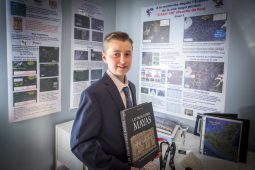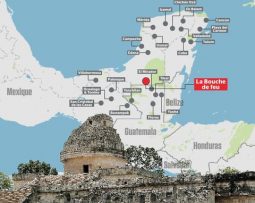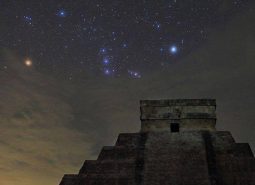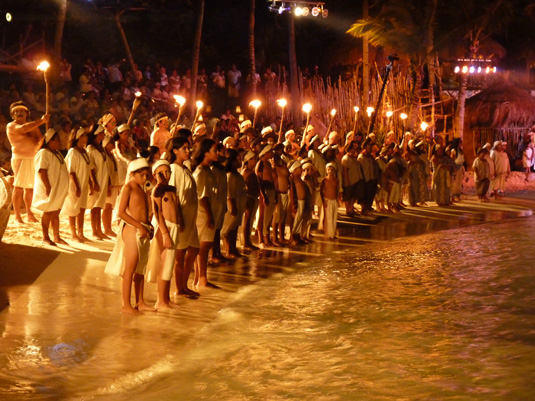“Academic mafia” attempt hit on teen’s lost Mayan city research. Here’s why.
What the recent public smack down of Canadian teen’s lost Mayan city theory reveals about modern academia.
 What started earlier this week as a light-hearted human interest story in a Canadian French-language newspaper about Quebecker teen William Gadoury’s middle school science fair project transformed days later into a worldwide controversy when Mayanist scholars attempted to debunk his claims that the Maya possibly used constellations to situate their cities. The academic community’s reaction was so rapid and fierce that one would have thought this teen’s science fair project was threatening to undermine over a century of Mayan scholarship and topple the entire discipline.
What started earlier this week as a light-hearted human interest story in a Canadian French-language newspaper about Quebecker teen William Gadoury’s middle school science fair project transformed days later into a worldwide controversy when Mayanist scholars attempted to debunk his claims that the Maya possibly used constellations to situate their cities. The academic community’s reaction was so rapid and fierce that one would have thought this teen’s science fair project was threatening to undermine over a century of Mayan scholarship and topple the entire discipline.
One of the most scathing attacks came from one of the most prominent Mayan scholars, Dr. David Stuart of the University of Texas. Known for helping decipher the enigmatic hieroglyphs the Maya used to write their language starting when he, himself, was just a teen Stuart dismissed Gadoury’s research as “junk science.” The effect on the public discussion was immediate— the news media declared Gadoury’s claims “debunked” and moved on to the next manufactured controversy. One can only imagine the long-term effect, though, on the teenager himself to being so publicly rebuked in the worldwide press by the most preeminent researchers in the field.
But does Stuart’s dismissive characterization of Gadoury’s research as “junk science” even hold up to scrutiny? What is science and is archaeology even a “science” to begin with?
The “Science” of Archaeology
Science is distinguished from non-scientific endeavors by its rigorous application of a set of principles known as the “scientific method.” What is this method and did Gadoury apply this method to his middle school science fair project?
The scientific method, according to Wikipedia, “…involves making conjectures (hypotheses), deriving predictions from them as logical consequences, and then carrying out experiments based on those predictions.” A diagram accompanying the Wikipedia article simplifies the process into seven steps:
- Make Observations (What do I see in nature?)
- Think of Interesting Questions (Why does that pattern occur?)
- Formulate Hypotheses (What are the general causes of the phenomenon I am wondering about?)
- Develop Testable Predictions (If my hypothesis is correct, then I expect a, b, c…)
- Gather Data to Test Predictions (Relevant data can come from the literature, new observations, or formal experiments.)
- Refine, Alter, Expand, or Reject Hypotheses
- Develop General Theories
 Did Gadoury follow this methodology? Based on a reading of multiple news accounts and interviews with Gadoury, it appears he did, in fact, follow these steps. He first made an observation that many Mayan sites were built away from rivers and in other undesirable locations. He then asked why the Maya would build their cities in such locations. He then formulated a hypothesis that the Maya may have used constellations to influence the site location for their cities. Gadoury next developed testable predictions; i.e., if his hypothesis was correct then he expected a map of Mayan sites to match a map of star patterns. He next overlaid a star map of the constellation Cassieopeia over a map of Mayan sites in the Yucatan peninsula and found they matched. He then refined and expanded his hypothesis by overlaying other constellations atop maps of Mayan sites and found more correspondences. He then developed a general theory that the Maya possibly located their cities according to the stars.
Did Gadoury follow this methodology? Based on a reading of multiple news accounts and interviews with Gadoury, it appears he did, in fact, follow these steps. He first made an observation that many Mayan sites were built away from rivers and in other undesirable locations. He then asked why the Maya would build their cities in such locations. He then formulated a hypothesis that the Maya may have used constellations to influence the site location for their cities. Gadoury next developed testable predictions; i.e., if his hypothesis was correct then he expected a map of Mayan sites to match a map of star patterns. He next overlaid a star map of the constellation Cassieopeia over a map of Mayan sites in the Yucatan peninsula and found they matched. He then refined and expanded his hypothesis by overlaying other constellations atop maps of Mayan sites and found more correspondences. He then developed a general theory that the Maya possibly located their cities according to the stars.
This seems to answer the question of whether Gadoury followed the scientific method. Clearly he did. But what of the other question: is archaeology even a science to begin with?
In 2010 the American Anthropological Association (AAA) seemingly answered that question when it removed the word “science” from the organization’s mission statement. As reported in the Chronicle of Higher Education:
“The old mission statement declared that the AAA’s purpose ‘shall be to advance anthropology as the science that studies humankind in all its aspects.’ The new statement jettisons ‘science’ in favor of ‘public understanding.’ It begins, ‘The purposes of the Association shall be to advance public understanding of humankind in all its aspects.’”
After an uproar within the academic community similar to what happened with Gadoury’s claims the AAA compromised and issued the following new mission statement:
“The strength of Anthropology lies in its distinctive position at the nexus of the sciences and humanities…The purpose of the Association shall be to advance scholarly understanding of humankind in all its aspects … drawing from and building upon knowledge from biological and physical sciences as well as the humanities and social sciences.”
 Interestingly, it made no overt mention of archaeology being a science. There are certainly scientific aspects to archaeology. The way sites are mapped, excavated, recorded and analyzed are certainly done according to rigorous scientific standards. Yet you can give this data to two different archaeologists and they will interpret it completely differently.
Interestingly, it made no overt mention of archaeology being a science. There are certainly scientific aspects to archaeology. The way sites are mapped, excavated, recorded and analyzed are certainly done according to rigorous scientific standards. Yet you can give this data to two different archaeologists and they will interpret it completely differently.
Furthermore, there are rarely any experiments that can be performed to get a more definitive answer. Thus archaeology is always open to different interpretations unlike “hard” sciences like biology. If a biologist believes he’s invented a vaccine to cure polio he can perform an experiment to test his hypothesis. Other laboratories can then repeat these experiments to verify his claims. The results of the experiments speak for themselves and no interpretation is needed.
The Academic Mafia
So what can explain the irrational overreaction by archaeology “professionals” to a teenager’s middle school science fair project? Perhaps one of the most famed Mayan scholars, Michael D. Coe, who literally wrote the book on the ancient Maya and was an early mentor to Stuart, offers an explanation from an interview he gave to the magazine Americas back in 1996 when he stated:
“Most anthropologists are so fuddy-duddy. They’re not willing to let their minds roam ahead, speculate….There used to be more freedom of thought and expression, less worry about what peers said. Today there’s sort of an academic mafia that runs things….If you say the wrong thing, you’re bad and you don’t get in… There are reputable publications that won’t accept papers written based on anything but stuff dug up by archaeologists.”
In other words, the modern academic establishment is so insecure about their status as scientists they will dismiss any theory that cannot be supported by physical artifacts dug from the ground. So until an archaeologist unearths a temple with an inscription that explicitly states that the Maya built their cities according to constellations, the academics will simply dismiss Gadoury’s claims as “junk science.” No matter how much evidence Gadoury presents it will all simply be dismissed as “coincidental” and “proving nothing.”
In fact, Coe’s comparison of the academic establishment to the mafia suggests they will not only dismiss new claims not supported by artifacts but actively attempt to destroy those who promote such claims. The attacks on not only Gadoury but also the people who helped him is a testament to this dark side of academia.
This seems to be the best explanation for the bizarre overreactions of the academic establishment over the past week to Gadoury’s claims. Apparently this academic mafia no longer confines their wrath to other academics but will even direct hits at teenagers who dare propose an idea not sanctioned by establishment Godfathers.


